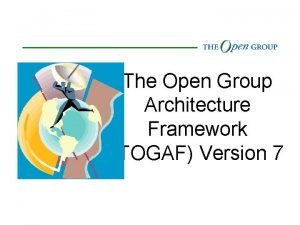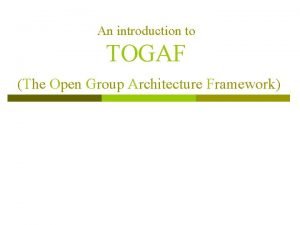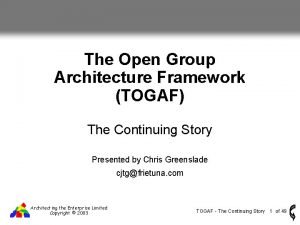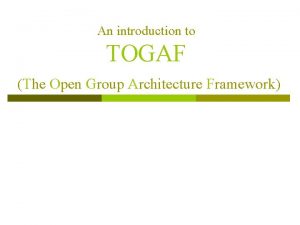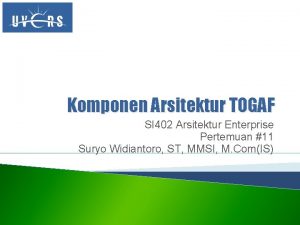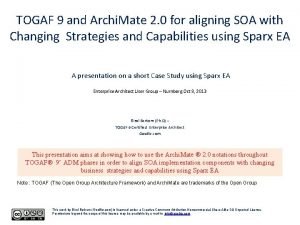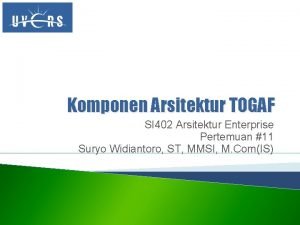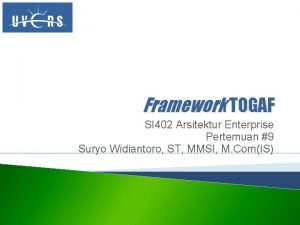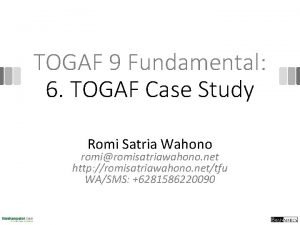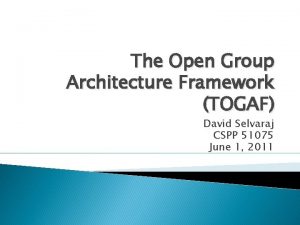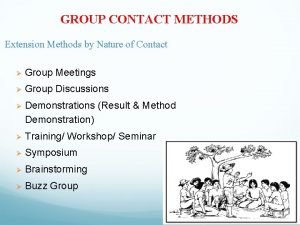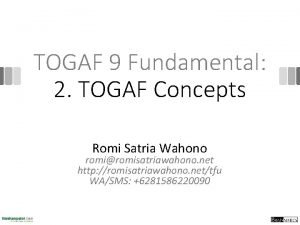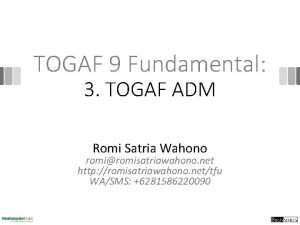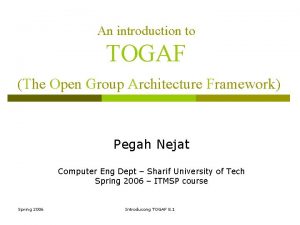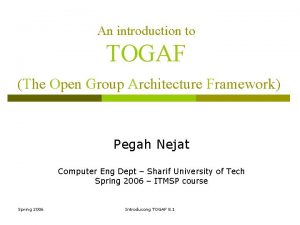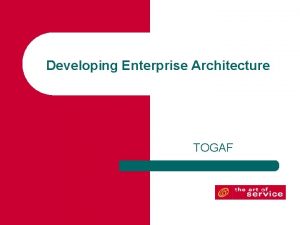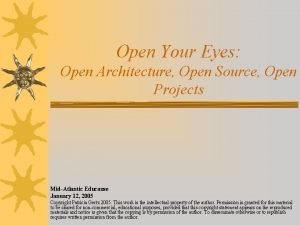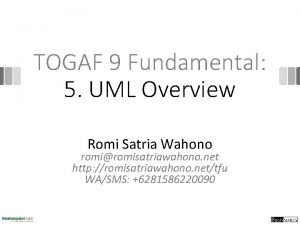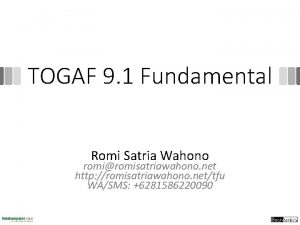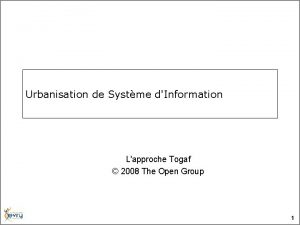Open Architecture Methods TOGAF The Open Group Architecture


















- Slides: 18

Open Architecture Methods: TOGAF (The Open Group Architecture Framework) A Presentation to the Real-Time and Embedded Systems Forum, Boston, 23 rd July 2003 John Spencer Graham Bird Director, Architecture Forum Vice President j. spencer@opengroup. org Mobile +1 415 999 3106 GSM +44 7771 863 9088 g. bird@opengroup. org (C) The Open Group 2003 Apex. Street Plaza 44 Montgomery Forbury Road, Suite Reading 960 Berkshire, RG 1 1 AX San Francisco, CA United Kingdom 94104 USA Tel+1 +44 118 950 8311 x 2244 Tel 415 374 8280 ext. 200 Fax+44 +1 118 415 950 374 0110 8293 www. opengroup. org

Agenda q The Architecture Forum q TOGAF § background § components q Summary 1/1/2022 2 (C) The Open Group 2003

Architecture Forum – Vision and Achievements An effective, open framework TOGAF “Enterprise Edition” and method TOGAF “Technical Edition” Target q ADM TRM SIB Resource Base TOGAF q. TOGAF Knowledgeable and Training Certification professional practitioners TOGAF Practitioner Certification TOGAF Prof. Svcs. Certification Adequate “Commercial Off-The -Shelf” tools TOGAF Tool Support Certification q 1/1/2022 3 (C) The Open Group 2003 BBIB

TOGAF Origins q. A customer initiative q A framework, not an architecture § A framework for developing architectures to meet different business needs § Not a “one-size-fits-all” architecture q Originally based on TAFIM (U. S. Do. D)

TOGAF Development q 1994: Requirement Proof of need q 1995: TOGAF Version 1 Proof of concept q 1996: TOGAF Version 2 Proof of application q 1997: TOGAF Version 3 Relevance to practical architectures (building blocks) q 1998: TOGAF Version 4 Enterprise Continuum (TOGAF in context) q 1999: TOGAF Version 5 Business Scenarios (architecture requirements) q 2000: TOGAF Version 6 Architecture views - IEEE 1471 q 2001: TOGAF Version 7 Architecture Principles; Compliance Reviews q 2002: TOGAF Version 8 Extension to Enterprise Architecture

TOGAF Scope q TOGAF covers the development of four related types of architecture: § § 1/1/2022 TOGAF 7 “Technical Edition” Business architecture Data or information architecture TOGAF 8 “Enterprise Edition” Application architecture Technology architecture TOGAF 7 “Technical Edition” 6 (C) The Open Group 2003

TOGAF Version 8 (“Enterprise Edition”) q q An effective, industry standard framework and method for enterprise architecture. Complementary to, not competing with, other enterprise frameworks § Use in conjunction with frameworks having defined deliverables more specific to particular sectors. q q q 1/1/2022 “Demystifies” architecture development Emphasizes business goals as architecture drivers A framework and method for achieving the “Boundaryless Information Flow” vision 7 (C) The Open Group 2003

TOGAF Structure and Components q q Architecture Development Method (ADM) Reference Architectures § Foundation Architecture § Technical Reference Model § Standards Information Base § Boundaryless Information Flow Reference Model (TOGAF Version 8) § Enterprise Continuum (reference architecture “framework”) q 1/1/2022 Resource Base 8 (C) The Open Group 2003

TOGAF ADM Overview q q q 1/1/2022 An open, industry consensus method for IT architecture Developing an organization-specific architecture to address business needs Architecture views to ensure that complex requirements are adequately addressed Practical, experience based guidance Adaptable to specific needs of a project 9 (C) The Open Group 2003

“Enterprise” ADM – Key Points q q An iterative method Each iteration = new decisions: § § q Enterprise coverage Level of detail Time horizon Architecture asset re-use: § previous ADM iterations § other frameworks, system models, industry models, …) A H Implementation Governance Requirements F Migration Planning (C) The Open Group 2003 B Business Architecture C G Decisions based on: 10 Architecture Vision Architecture Change Management § Competence / resource availability § Value accruing to the enterprise. 1/1/2022 Prelim: Framework and Principles Information System Architectures D E Opportunities and Solutions Technology Architecture

Foundation Architecture: Technical Reference Model Qualities Infrastructure Applications q Business Application Programming Interface § Graphics & Image Data Management Data Interchange International Operations User Interface Location & Directory Transaction Processing System & Network Management Security Software Engineering Operating System Services Network Services Communications Infrastructure Interface Communication Infrastructure 1/1/2022 11 Associated with detailed taxonomy of services (C) The Open Group 2003 q defines scope of each service category Identifies system-wide capabilities or “qualities”; e. g. : § § Security Manageability

Foundation Architecture: Standards Information Base (SIB) q q 1/1/2022 A database of open industry standards § The complete set of Open Group endorsed standards § Content determined by Open Group consensus process Structured according to TOGAF Technical Reference Model taxonomy Available for public web access § http: //www. db. opengroup. org/sib. htm Gateway to many linked resources 12 (C) The Open Group 2003

Boundaryless Information Flow Reference Model q q q 1/1/2022 A model of the major component categories for developing, managing, and operating an integrated information infrastructure. A model of a set of applications that sit on top of an application platform. An expanded subset of the TOGAF Technical Reference Model, using different orientation. 13 (C) The Open Group 2003

Boundaryless Information Flow Reference Model – Detailed Model Qualities Security Mobility Application Platform Information Consumer Applications Web Portal Streaming audio / video information Access Directory Referencing/Dereferencing Naming Registration Publish Subscribe Discovery Languages Libraries Registries Application Message Format Application Messaging Application to application communications services Enterprise Appl Integration Brokering Applications Business modeling tools Design tools Construction tools Languages and Libraries Information Brokers Application Integrators Management Utilities Monitors Executory Utilities Copy Managers Information Provider Applications information Access Performance 14 Presentation Transformation Browser services Portal and personalization Meta indices Information Access Transformation Mapping Query distribution Aggregation Search File services Desktop Video Conference Web services Phone / Fax Info Format e. Form services Instant messaging services Messaging/Event Brokering 1/1/2022 Phone / Fax Mail Development Tools Digital Signature Intrusion Detection Key Management Firewall Encryption AAAC Web Portal SSO Streaming audio / video Desktop Video Conference Mail Process/Workflow Control Qualities (C) The Open Group 2003 Manageability

The “Enterprise Continuum” Architecture Continuum Foundation Architectures Guides & Supports Common Systems Architectures Guides & Supports Products & Services Industry Architectures Guides & Supports Systems Solutions Organisation Architectures Guides & Supports Industry Solutions Continuum 1/1/2022 15 (C) The Open Group 2003 Organisation Solutions

Resource Base q 1/1/2022 Resources available in applying the TOGAF Architecture Development Method; e. g. § Architecture Compliance Reviews § Architecture Principles § Architecture Views § Architecture Tool evaluation criteria § Business Scenarios (requirements method) § Case Studies § Comparisons with other Frameworks § IT Governance Strategies § Mapping to Zachman Framework 16 (C) The Open Group 2003

For More Information. . . q The Architecture Forum: § http: //www. opengroup. org/architecture/ q Viewing TOGAF on-line: § TOGAF Version 8: § http: //www. opengroup. org/architecture/togaf 8 -doc/arch/ § TOGAF Version 7: § http: //www. opengroup. org/architecture/togaf 7 -doc/arch/ q TOGAF licensing and downloads: § TOGAF Version 8: § http: //www. opengroup. org/architecture/togaf 8/index 8. htm § TOGAF Version 7: § http: //www. opengroup. org/architecture/togaf 7/index 7. htm 1/1/2022 17 (C) The Open Group 2003

1/1/2022 18 (C) The Open Group 2003
 Togaf the open group architecture framework
Togaf the open group architecture framework Togaf trm
Togaf trm Togaf
Togaf Togaf wheel
Togaf wheel Togaf introduction
Togaf introduction Meeting architecture
Meeting architecture Togaf9
Togaf9 Arsitektur enterprise
Arsitektur enterprise Adm togaf
Adm togaf Pengantar togaf
Pengantar togaf Togaf example case study
Togaf example case study The open group architecture framework
The open group architecture framework Direct wax pattern technique
Direct wax pattern technique 영국 beis
영국 beis Disadvantages of group contact method
Disadvantages of group contact method Hình ảnh bộ gõ cơ thể búng tay
Hình ảnh bộ gõ cơ thể búng tay Bổ thể
Bổ thể Tỉ lệ cơ thể trẻ em
Tỉ lệ cơ thể trẻ em
